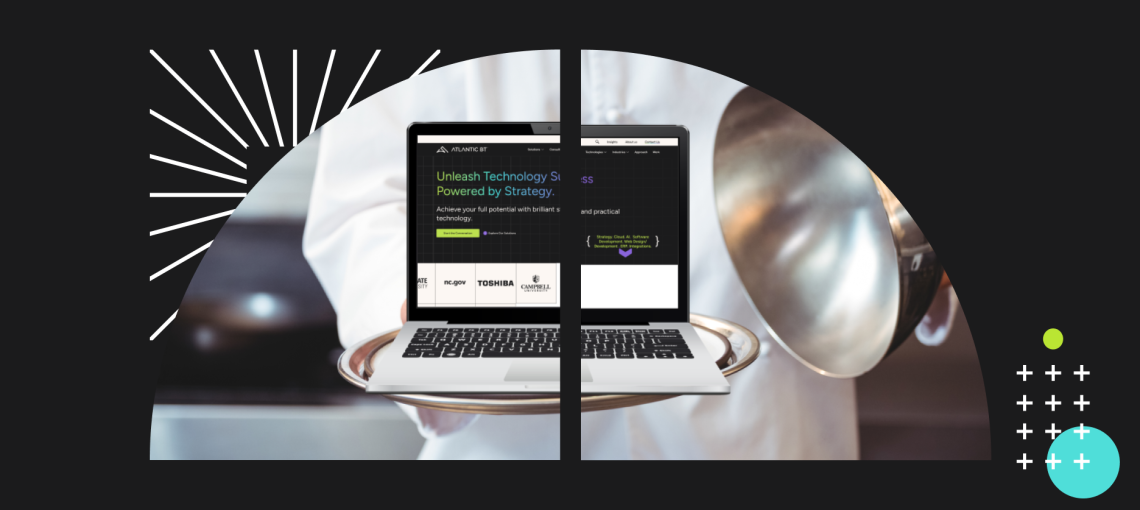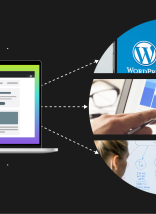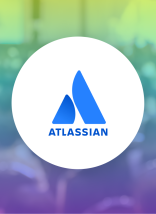In two previous posts, I compared 1) website planning and development with custom house building, and 2) website maintenance with owning a vehicle.
In this post, I correlate the fine dining experience to working with an agency who is building your custom website or web application. This will make fewer technical correlations, but instead focus more on the people and process involved in bringing your project to life. And yes, I did make myself hungry while writing this article.
Getting Seated
You walk into the restaurant. The atmosphere is calm, the lighting is warm and soft, and you approach the host. There’s a short introduction, and they make you feel welcome. Maybe you made reservations earlier, but maybe not. If not, you put your name on the list and relax in the lobby. At some point (now or later), the host calls your name, and you make your way to the table. They inform you who will be your server for the evening, and soon that person arrives.
Surprisingly, the sales process can and should follow a similar path. Once you reach out to a vendor and you’re introduced to a sales representative, hopefully you feel at ease. Sure, you’re having discussions about schedule, scope, and budget when planning a project (which doesn’t happen while waiting in the lobby for your table), but you’re learning if your companies are a fit. It’s clear you’ve found a vendor who understands your needs, cares about your success, and budgets align. Eventually a contract is agreed upon, you’re assigned team members, and a kickoff meeting is occurs.
What’s on the Menu?
With fine dining, there are a lot of interactions with staff once you are at your table. Many of them are with your server. To start, water is brought to the table and drink orders are taken. While the server gets your drinks from the bartender, you start browsing the menu. Your drinks arrive, and you have questions about the menu. The server has answers to most, but they go and ask the chef about one particular detail.
It’s a multi-course meal, so you put in appetizer orders while you think more about the entree. A sommelier arrives, and they discuss with you the varieties of wine that pair well with the meals you’re considering. Your party discusses everyone’s ideas, you ask a few last questions of the server, and they take your order.
Discovery and design phases of web development also include many meetings and conversations. Many. Your digital project manager is going to be your point person throughout the project. They’ll facilitate meetings, answer your questions, and provide you updates.
In discovery, instead of you asking the bulk of the questions, it’s more common to provide the answers to many people as goals and requirements are identified. A UX researcher is a team member who is heavily involved in discovery. During the design phase, a UX/UI designer takes lead on visual design and a developer or architect provides technical design. It’s common for you to bring designs (UI mockups) to your team or stakeholders for review. Eventually, everything is approved, and the development phase begins.
Let’s Get Cooking
Your order’s been placed – and the waiting begins. You’re not abandoned, but you have your drinks and the heavy decision making is complete, so you have some time for yourself and your party. The server still checks in with you, refills drinks as needed, and you may see other team members such as food runners who bring you the appetizer and later your salad.
But there’s a lot more people involved with your meal. A line cook makes your appetizers and prepares your salad. In the meantime, the head chef is preparing the entree with the assistance of a saucier. Finally, a sous chef reviews your meal to make sure everything is absolutely perfect. Remember, you don’t get to see any of this!
It’s honestly the same in web development, except this process takes weeks or months – not minutes or hours. You’ve reviewed wireframes, mockups, and data design documents, but now your website is being developed behind the scenes. It can be difficult to have no tangible progress for a while after so much engagement. Eventually, the digital project manager will schedule demonstrations or screenshare progress during status meetings.
The team, meanwhile, is busy. Back end and front end developers are creating the code base and building features. Every feature has to be developed, including code reviews by other developers. Cloud engineers work with developers to set up deployments. Quality assurance team members are testing the site throughout against acceptance criteria. Soon enough (okay, maybe not soon enough), the website is ready to be launched!
The Meal Arrives
Your meal arrives. Appetizer and salad plates have been cleared, food runners place the plates in front of you, and your server gets a ramekin of sauce you realize you didn’t ask for earlier. The fanfare is quick, and then you’re free to dig in. Shortly after, your server checks in again making sure everything’s as expected. Later, while you’re still enjoying the meal, the house manager or general manager stops by too. The staff may have completed most of the work, but you still feel taken care of.
Launch day for your website is a big deal. Your old website is taken down and the new one is made available to the public. There’s lots of communication and excitement. A couple of small bugs are found and resolved quickly. Your digital project manager continues to be on point and coordinate with the team as you provide positive feedback, find a few problems, and maybe ask for a couple of small changes you didn’t realize you wanted before. It’s also common that your original salesperson, or an executive, also checks in with you to make sure your website and experience with the team are both satisfactory.
You Don’t Leave After the Meal Arrives
You sit back, your entree devoured. Hopefully, no one at your table unbuttons their top pants button. This is a fine meal, at a fine restaurant, in fine company – you don’t have to leave immediately! You decide to have a cup of coffee, or an after dinner drink. The server mentions a few special desserts that are available, and one of them is too good to pass up.
Your website has been up and running, launch announcements have been posted, and you and your team are focused back on other company initiatives. That doesn’t mean you abandon the website though. You have some articles planned out to add over the next few months. You and your staff, now really using the website regularly, have a few ideas for new features. Plus, the website needs regular updates and maintenance for security purposes and to keep it from getting out of date.
What Doesn’t Fit
So far, this article is more around experience than specific technical aspects of development, most of the comparisons work reasonably well. However, there are a few areas that don’t line up.
Cloud Hosting. We can draw direct comparisons of developers with line cooks, and sous and head chefs with lead devs and quality assurance, but there’s not a great correlation with cloud engineering. If the meal is the website, there’s no food correlation to cloud hosting engineers – no one really in charge of the building, security, and repairing of cookware and plates. Sure, a general manager might be in charge of locking up the building and ordering or replacing cookware – but no one is crafting individual plates or creating individual access policies for the pots.
Content. With a dining experience, after you’ve decided what you want to eat, your job is complete (except for eating). If your website is a large content website, however, you may have a significant responsibility – adding content. Depending on the technology and budget, the vendor may be able to build the entire site without your assistance. Honestly, this is rare. You likely have new pages you want to write, older content to clean up, and some older web pages to delete. It may be more efficient or cost effective to have your staff learn and build the pages themselves. No restaurant is going to let you into the kitchen in order to do some of the cooking yourself!
Payment. One other departure comparing a fine meal with custom development is how payment is handled. With a meal, it’s a single evening that’s paid for in full after all services are rendered. Vendor relationships are different, and web development projects are larger, so an invoicing schedule is usually agreed upon as part of the contract.
A Restaurant You Never Leave?
I think it’s important here to wrap up by calling attention to the fact that the website launch doesn’t correlate to the end of a fine dining experience but rather the middle. And honestly, if you have a good relationship with your vendor and understand that a website isn’t a product but a service, that website launch may fall in the very early part of a long endeavor spanning many years.
And lastly, even though it doesn’t feel like it while you’re at the restaurant, you will need to eat again. A well developed website with ongoing maintenance can last a long time but not forever!
The Series Is Complete
I hope this article and the others in the series help to provide you with more insightful context for your next website or web application project, and maybe liaise better with the vendor. It’s been enjoyable to map out the complexities of web development with more common and relatable experiences.
I hope your next project is with Atlantic BT, but even if it’s with another agency – I hope your home building, car maintenance, fine dining adventure of custom web development goes extremely well!






